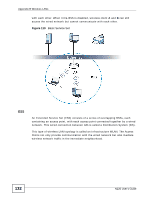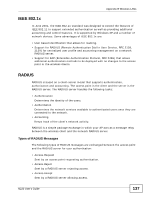ZyXEL N220 User Guide - Page 136
Wireless Security Overview, Table 28
 |
View all ZyXEL N220 manuals
Add to My Manuals
Save this manual to your list of manuals |
Page 136 highlights
Appendix B Wireless LANs several intermediate rate steps between the maximum and minimum data rates. The IEEE 802.11g data rate and modulation are as follows: Table 28 IEEE 802.11g DATA RATE (MBPS) MODULATION 1 DBPSK (Differential Binary Phase Shift Keyed) 2 DQPSK (Differential Quadrature Phase Shift Keying) 5.5 / 11 CCK (Complementary Code Keying) 6/9/12/18/24/36/ OFDM (Orthogonal Frequency Division Multiplexing) 48/54 Wireless Security Overview Wireless security is vital to your network to protect wireless communication between wireless clients, access points and the wired network. Wireless security methods available on the N220 are data encryption, wireless client authentication, restricting access by device MAC address and hiding the N220 identity. The following figure shows the relative effectiveness of these wireless security methods available on your N220. Table 29 Wireless Security Levels SECURITY LEVEL SECURITY TYPE Least Secure Unique SSID (Default) Unique SSID with Hide SSID Enabled MAC Address Filtering WEP Encryption IEEE802.1x EAP with RADIUS Server Authentication Wi-Fi Protected Access (WPA) WPA2 Most Secure Note: You must enable the same wireless security settings on the N220 and on all wireless clients that you want to associate with it. 136 N220 User's Guide















